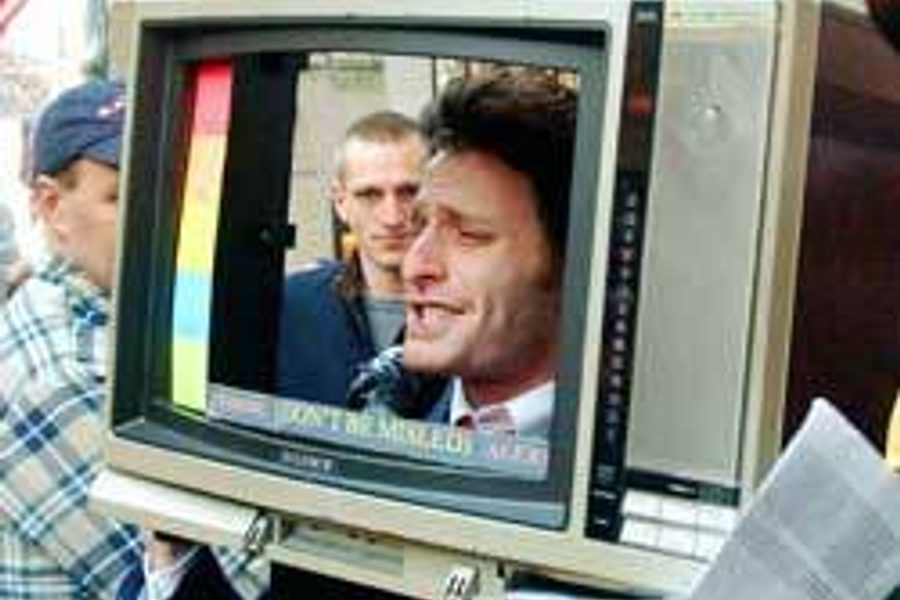
My notebook made me a marked man. “Are you a journalist?” asked a young woman, peeking over my shoulder.
By then, the first half of the huge anti-war parade slowly proceeding down Broadway had disbanded into Washington Square Park, where hundreds of young marchers were holding a spontaneous protest carnival. There were people kneeling with chalk sticks to small draw peace symbols on every single one of the thousands of plaza tile stones. A woman was dancing with an Indian feather stick in a drumming circle while a trumpeter in pink glasses played “God Bless America.” There was a breakdancing team, a police helicopter hovering overhead, a flock of pigeons chased up into the trees. I was watching a circle of students dancing a jittery sort of pogo bounce. They chanted with a rapid musical cadence that almost sounded gentle:
“Are you a journalist?” she asked for the second time. “I’ve been pretty disappointed in journalists so far.”
Actually, she sounded polite, even deferential. I got off easy. Minutes later, a young man cornered me by a police van parked at the corner of Washington Square and playing a message over its loudspeakers telling the incoming marchers to disperse to make room for the people still behind them. To me, the message made sense. The square couldn’t hold 200,000 people. But this young man was incensed. “They’re playing it every 75 seconds. They can’t tell us the march is over,” he said, pleading with me. He seemed to think that the reporter’s notebook in my hand gave me the power to tell the van to shut up. He seemed to believe in some mystical power of the press.
Anger against the media was a palpable part of the anti-war march on March 22 in New York. “CNN Lies!” was the chant. “Weapons of Mass Distraction” read the handmade poster with a television drawn in the corner. “Why Protest Corporate Media?” was the headline of a flier that offered at least a dozen reasons. One marcher even wore the empty plastic box of a TV set over his shoulders so that his head appeared “on the air” nodding and smirking at us like a braindead anchorman.
To be honest, I was surprised by this anger. Perhaps I’m too cynical or naive, or both, but I wanted to ask: What do you expect? The problem isn’t just corporate media. It’s the medium of television.
————–
Over the years, some astute critics of television have argued that the technology itself severely limits what the boob tube can tell us about the world: It favors individuals over groups, simple opinions over complex ideas, fast action over the true pace of life. And, unfortunately for progressives, many of the things we cherish play poorly on TV. For example, how well would they cover this march?
The first television news team I spotted was standing on a side street in the Thirties. The reporter was a striking young blonde in a camel-hair coat and khaki slacks holding a Channel 7 microphone down at her side, a tool for a job she wasn’t eager to begin. I was reminded of an NPR book reviewer who once told me that radio is performing, television is modeling. And had I seen this reporter on the news, I might have resented her and her beauty. But in person, I experienced the opposite. I felt genuine empathy for her. I wondered if she resented having to work on Saturday when everyone else was having fun protesting. I wondered if she felt overdressed for this crowd. (Even the man carrying a “Corporate Lawyers Against War” placard had taken off his suitcoat and tie, if not his white shirt and dark slacks.) I wondered if she felt like someone forcing herself to crash a party that really wasn’t her style. Fortunately, her cameraman seemed at ease with New York street crowds, so he led her out to find an interview.
To me, the splendor of this march was the amazing diversity of people, placards, costumes, everything down to the drums, which ranged from paint buckets to stove pots to office water cooler jugs. Everywhere I looked I saw colorful characters. A man in a black T-shirt with skeleton ribs. A woman with tousled-hair holding up a sign: “The Only Bush I Trust Is My Own.” Three petite Japanese women in white helmets who smiled shyly to one another while carrying a banner: “Smash the Evils of Imperialist America.”
Yet, from all this diversity, the reporter chose an avuncular white man with graying hair, heavy eyebrows and reading glasses that hung over the open collar of his casual dress shirt. No doubt he represented a “normal” American amid this crowd of exuberant radicals, bohemians and fashionable Manhattanites. But he also seemed a safe bet for her interview. He was friendly and respectful. At the end, he wished her well with a big smile and touched her sleeve, almost as if he’d been talking with his own niece about her exciting new job as a television reporter. He’d been having a conversation with a person, not with a television camera. And, yet, I wondered what the television audience would see: 10 seconds of his animated, conflicted face as he answered her question about patriotism, which would be sandwiched between her own calm appearance on camera, introducing him and summing up. In the context of this raucous parade, he had looked pretty thoughtful to me, but on the television news he might just seem angry.
————–
Farther down Broadway, I came to television command central in Herald Square. The police had barricaded off a full lane for the broadcast trucks with their telescope poles raised skywards and satellite dishes aimed downtown. Behind the metal barrier the crowd was squeezed like a wallpaper mob. On the television side, the reporter had plenty of room. He was a handsome young black man dressed in a dark blue shirt who focused on the camera tripod about 12 feet away. A second tripod cast extra light on his face, even on this sunny afternoon. And I was impressed by his concentration, his calm, his confidence. He didn’t look like the rest of us with all of our anger, uncertainty and hope.
Then he turned to interview a mother pinned against the barrier with her son, who was perhaps 6 years old and apparently unaware he was on television. She, too, looked “normal” in her casual weekend clothes, although she wore an American flag scarf, and she, too, grew passionate when asked about patriotism. After she finished, the reporter turned back to the camera and wrapped up his story with the same stoic face. Not until he was off the air did he seem to reveal his true mood by responding to one of the guys on the set with a jockish smile.
What would television tell someone about this rally? Almost nothing I considered worth remembering. Not the infectious spirit of defiance, the ribald humor of the placards, or the sense of kinship with thousands of strangers. Not the warmth of the sun after such a harsh winter or the yellowness of the daffodils in several marchers hands. Not the feeling of hope, at least for an afternoon, that we could reclaim our country from the Bush administration.
And certainly not what I found moments later performing 30 feet from the television trucks in the triangle park of Herald Square. A street theater group of women were dressed up like campy clowns with silver, blue and orange wigs, with Victoria Secret-style bras and panties pulled over their blue tights. For the finishing touch, they each wore a two-foot-long silver rocket strapped on like a dildo. They performed a choreographed routine and sang with the perkiness of cheerleaders:
By then, the first half of the huge anti-war parade slowly proceeding down Broadway had disbanded into Washington Square Park, where hundreds of young marchers were holding a spontaneous protest carnival. There were people kneeling with chalk sticks to small draw peace symbols on every single one of the thousands of plaza tile stones. A woman was dancing with an Indian feather stick in a drumming circle while a trumpeter in pink glasses played “God Bless America.” There was a breakdancing team, a police helicopter hovering overhead, a flock of pigeons chased up into the trees. I was watching a circle of students dancing a jittery sort of pogo bounce. They chanted with a rapid musical cadence that almost sounded gentle:
One, two, three, four, we don’t want your fucking war.People half my age were creating their own protest culture. I jotted it down in my notebook, one of dozens of observations about the rally.
Five, six, seven, eight, stop the violence, stop the hate.
“Are you a journalist?” she asked for the second time. “I’ve been pretty disappointed in journalists so far.”
Actually, she sounded polite, even deferential. I got off easy. Minutes later, a young man cornered me by a police van parked at the corner of Washington Square and playing a message over its loudspeakers telling the incoming marchers to disperse to make room for the people still behind them. To me, the message made sense. The square couldn’t hold 200,000 people. But this young man was incensed. “They’re playing it every 75 seconds. They can’t tell us the march is over,” he said, pleading with me. He seemed to think that the reporter’s notebook in my hand gave me the power to tell the van to shut up. He seemed to believe in some mystical power of the press.
Anger against the media was a palpable part of the anti-war march on March 22 in New York. “CNN Lies!” was the chant. “Weapons of Mass Distraction” read the handmade poster with a television drawn in the corner. “Why Protest Corporate Media?” was the headline of a flier that offered at least a dozen reasons. One marcher even wore the empty plastic box of a TV set over his shoulders so that his head appeared “on the air” nodding and smirking at us like a braindead anchorman.
To be honest, I was surprised by this anger. Perhaps I’m too cynical or naive, or both, but I wanted to ask: What do you expect? The problem isn’t just corporate media. It’s the medium of television.
————–
Over the years, some astute critics of television have argued that the technology itself severely limits what the boob tube can tell us about the world: It favors individuals over groups, simple opinions over complex ideas, fast action over the true pace of life. And, unfortunately for progressives, many of the things we cherish play poorly on TV. For example, how well would they cover this march?
The first television news team I spotted was standing on a side street in the Thirties. The reporter was a striking young blonde in a camel-hair coat and khaki slacks holding a Channel 7 microphone down at her side, a tool for a job she wasn’t eager to begin. I was reminded of an NPR book reviewer who once told me that radio is performing, television is modeling. And had I seen this reporter on the news, I might have resented her and her beauty. But in person, I experienced the opposite. I felt genuine empathy for her. I wondered if she resented having to work on Saturday when everyone else was having fun protesting. I wondered if she felt overdressed for this crowd. (Even the man carrying a “Corporate Lawyers Against War” placard had taken off his suitcoat and tie, if not his white shirt and dark slacks.) I wondered if she felt like someone forcing herself to crash a party that really wasn’t her style. Fortunately, her cameraman seemed at ease with New York street crowds, so he led her out to find an interview.
To me, the splendor of this march was the amazing diversity of people, placards, costumes, everything down to the drums, which ranged from paint buckets to stove pots to office water cooler jugs. Everywhere I looked I saw colorful characters. A man in a black T-shirt with skeleton ribs. A woman with tousled-hair holding up a sign: “The Only Bush I Trust Is My Own.” Three petite Japanese women in white helmets who smiled shyly to one another while carrying a banner: “Smash the Evils of Imperialist America.”
Yet, from all this diversity, the reporter chose an avuncular white man with graying hair, heavy eyebrows and reading glasses that hung over the open collar of his casual dress shirt. No doubt he represented a “normal” American amid this crowd of exuberant radicals, bohemians and fashionable Manhattanites. But he also seemed a safe bet for her interview. He was friendly and respectful. At the end, he wished her well with a big smile and touched her sleeve, almost as if he’d been talking with his own niece about her exciting new job as a television reporter. He’d been having a conversation with a person, not with a television camera. And, yet, I wondered what the television audience would see: 10 seconds of his animated, conflicted face as he answered her question about patriotism, which would be sandwiched between her own calm appearance on camera, introducing him and summing up. In the context of this raucous parade, he had looked pretty thoughtful to me, but on the television news he might just seem angry.
————–
Farther down Broadway, I came to television command central in Herald Square. The police had barricaded off a full lane for the broadcast trucks with their telescope poles raised skywards and satellite dishes aimed downtown. Behind the metal barrier the crowd was squeezed like a wallpaper mob. On the television side, the reporter had plenty of room. He was a handsome young black man dressed in a dark blue shirt who focused on the camera tripod about 12 feet away. A second tripod cast extra light on his face, even on this sunny afternoon. And I was impressed by his concentration, his calm, his confidence. He didn’t look like the rest of us with all of our anger, uncertainty and hope.
Then he turned to interview a mother pinned against the barrier with her son, who was perhaps 6 years old and apparently unaware he was on television. She, too, looked “normal” in her casual weekend clothes, although she wore an American flag scarf, and she, too, grew passionate when asked about patriotism. After she finished, the reporter turned back to the camera and wrapped up his story with the same stoic face. Not until he was off the air did he seem to reveal his true mood by responding to one of the guys on the set with a jockish smile.
What would television tell someone about this rally? Almost nothing I considered worth remembering. Not the infectious spirit of defiance, the ribald humor of the placards, or the sense of kinship with thousands of strangers. Not the warmth of the sun after such a harsh winter or the yellowness of the daffodils in several marchers hands. Not the feeling of hope, at least for an afternoon, that we could reclaim our country from the Bush administration.
And certainly not what I found moments later performing 30 feet from the television trucks in the triangle park of Herald Square. A street theater group of women were dressed up like campy clowns with silver, blue and orange wigs, with Victoria Secret-style bras and panties pulled over their blue tights. For the finishing touch, they each wore a two-foot-long silver rocket strapped on like a dildo. They performed a choreographed routine and sang with the perkiness of cheerleaders:
Shop in the name of warThen they continued on their way downtown with their phallic missiles wagging in the sunshine. The day we see that on television is the day we will see honest coverage of the war.
You need a whole lot more
Don’t think it over
Don’t think it over
Will Nixon lives in upstate New York. His web site is: www.mycabinfever.com.





